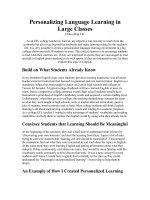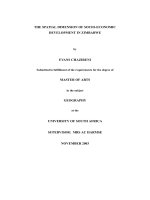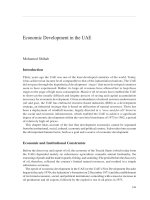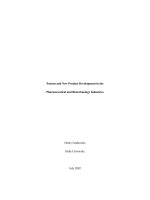Facilitating English Conversation Development in Large Classrooms
Bạn đang xem bản rút gọn của tài liệu. Xem và tải ngay bản đầy đủ của tài liệu tại đây (74.55 KB, 5 trang )
Facilitating English Conversation
Development in Large Classrooms
Gerry Gibson
This paper presents a number of teaching techniques that address the problems EFL
instructors face when teaching English conversation to a college class with a large number
of students. Using Long's Interaction Hypothesis as a general theory for a conversation
course design, I present both classroom management and pedagogical techniques that
ultimately aim to develop the students' conversation skills under such imperfect classroom
circumstances.
Introduction
Teaching English conversation to a large class of students is not considered ideal for
teaching. The sheer number of students that teachers must manage in these conversation
classes poses a daunting task in terms of designing a course that will serve to develop the
students' conversation skills. In order to effectively plan for such English conversation
courses it is vital for the teacher to have a grasp of how conversation skills can be
developed in the classroom. Based on Long's Interaction Hypothesis, this article will
introduce a variety of methods to help teachers overcome the belief that large classrooms,
although far from the ideal setting, cannot be fertile ground for developing students'
conversation skills.
The Interaction Hypothesis and Negotiated Interaction
When developing a conversation course regardless of the class size, taking the view of
developing students' conversation skills through negotiated interaction is an advisable point
of departure. That L2 students' can develop their Second Language Acquisition (SLA)
through interaction in EFL classrooms began with research in the early 1980s by Long
which eventually culminated in his Interaction Hypothesis (1983; 1996). Long found that
interaction in L2 learning gave rise to SLA opportunities through what he termed
interactional modification (1983). Now generally known as negotiated interaction or
negotiation of meaning, this process has been defined by Pica (1994: 418), amongst others,
as "the modification and restructuring of interaction that occurs when learners and their
interlocutors anticipate, perceive, or experience difficulties in message comprehensibility".
Likewise, Long (1996: 418) characterizes negotiated interaction for L2 learners in this
way:
the process in which, in an effort to communicate, learners and competent speakers provide
and interpret signals of their own and their interlocutor's perceived comprehension, thus
provoking adjustments to linguistic form, conversational structure, message content, or all
three, until an acceptable level of understanding is achieved.
Facilitating SLA Through Interaction
In terms of the conditions upon which SLA can be facilitated through interaction, Pica
(1994: 501-502) presents three learner-oriented and three language-oriented conditions that
can facilitate students' conversation development:
I. Learner-oriented conditions
• Message comprehension by the learner.
• Learner production of modified output.
• Attention to L2
form.
II. Language-oriented conditions
• Positive, grammatically systematic, L2 input.
• Enhanced L2 input saliency of subtle L2 features.
• Feedback and negative input.
In what follows, I will suggest methods of effectively facilitating SLA through interactive
and conversation based activities, as well ways for teachers to manage such a course.
Group Work and Weekly Student Leaders
Arranging the students in groups of four or five at the beginning of each class is the first
step towards developing students' conversation abilities and effectively managing large
classes. The tone for this must be set during the first week of classes in a semester.
Students need to understand that the first two or three minutes of each class will be used to
set up groups.
Setting students up in groups will serve to make monitoring the class a more efficient
process for the teacher. However, the dynamics of the group work must also be such that
the type of quality interaction that is necessary to facilitate SLA exists within the groups.
Assigning a weekly student leader to facilitate activities and overall group interaction
dynamics is an effective measure for both managing the large class and for attempting to
ensure groups stay on task throughout the duration of the class.
Student Leaders' Evaluation
In my conversation courses I allot a small percentage of the students' overall grade (5 to
10%) according to how well the student leaders perform. Performance features I take note
of when assigning a student leader's grade are the following:
• The group stays on task and completes their activities.
• Active participation by all group members.
• Predominant use of the L2 within the group.
• Small talk if students finish an activity earlier than expected.
If a leader facilitates the group work effectively, they will be awarded full marks for that
particular class. If the group fails to stay on task, if there is overuse of the L1, or if the
group appears to be inactive then the leader will be held partly accountable for this by
receiving a lower leaders grade. However, If I notice the leader making an effort to address
any weak areas within the group work then I do not penalize him. Again, the significance
of the leader's role is that it relieves the teacher from some of the burden of facilitating
activities and interaction, and in effect allows the teacher more opportunity to address the
actual interaction that occurs within the group. Ideally, each student should have the
opportunity to lead a group twice a semester. Also, each student must be assured of the
leader's duty at least once in order to make for fair grading.
Interaction Based Quizzes
Rather than giving written class quizzes based on material taken from a class textbook,
students are given a quiz on their ability to interact with one another. Set students up in
pairs and have them complete some type of information gap activity (object placement
activities, half-a-crossword, half-a-script, etc.,) where both students are forced to
communicate in order to discover missing information and complete an activity. Although
the students feel the pressure of having to take a quiz, they enjoy the interactive nature of
the quiz. More importantly, it serves as an evaluation of the students' communicative
abilities.
Communicative and Interaction Based Homework
Assignment
Another important facet of the course design for English conversation classes is coming up
with homework activities that address and develop the students' English conversation
skills. This can been accomplished by putting together a list of tasks that the students must
complete on a weekly basis, and that for the most part include some type of interaction.
Also, teachers should try to include a variety of interaction methods, including telephone
conversations with the teacher, face-to-face meetings with the teacher, three-way
discussions between a pair of students and the teacher, and e-mail correspondence with the
teacher.
In the first class of a semester I hand out a homework activity sheet that includes a variety
of tasks that need to be completed on a weekly basis. Here is an example of what the
weekly activities sheet might look like and a few ideas that I have used in the past:
Weekly Participation Homework Topics
First Week
Visit your teacher's office and give him some useful advice about how to live in Korea, or
advice on understanding Korean culture. You must speak for at least two minutes.
Second Week
Send an e-mail to your teacher that describes your favorite entertainer. The e-mail must be
between 8-10 lines.
Third Week
Call your teacher on his cellular phone and ask him how he is feeling. He will ask you for
some advice on something. You will have to give him advice that will help to solve his
problem. You must speak for at least two minutes.
Clearly, assigning such homework activities to a large group of students is a great deal of
work for the teacher. You will want to organize the homework submissions around how
many total students you have. If you have too many students to assign weekly interaction
homework to each student, then you should consider bi-weekly assignments for each
student with one group starting in week one and the second group starting in week two and
alternating from there. Here are some of the ways that I have managed facilitate interaction
and keep on top of the weekly homework assignments in.
How to Manage the Activities with a Large Class of
Students
• Enforce strict weekly deadlines for activities. Each weekly activity begins after
class and ends the night before the next class. I set a time deadline of 10:00pm the
night before their next class.
• Students don't have second opportunities to complete missed weeks. I do this for
the simple reason of time management. If the students know they can delay doing
their activities until the end of the semester they will, and this will result in a
nightmare for the teacher who attempts to handle all the visits, phone calls, and e-
mails at the end of the semester.
• Instruct students to always include their name, grade, class number, and any other
information on e-mail and telephone homework activities. For phone calls, at the
end of each conversation I always tell the student to send a text message in English
with the relevant student information so that I can input their grades easily when I
return to my office.
• Input student task completions immediately. If you do not do this you will quickly
lose track of who did what and when.
• Do not spend too much time with any one particular student. Keep a time limit of
two or three minutes of speaking time per student.
• Do not wait too long to reply to student e-mails. You need to dedicate a certain
amount of time each day or week to doing this.
How to Facilitate Interaction During Activities
• During speaking activities be wary of students who have memorized or are reading
from notes (over the phone). Legitimate questions concerning the message they are
attempting to communicate should be asked. Probing for further information from
the student is advisable, particularly if you feel that the content has been memorized
or is being read.
• Treat the conversation as an interaction with the student. If you are not sure of the
message the student is trying to communicate then negotiate meaning with the
student.
• Do not allow students who visit your office to use notes. They may refer to their
notes before beginning the task, but once the task has begun do not allow students
to use their notes. Instruct the students to prepare well before engaging in the
activity.
• Always encourage the students regardless of their communicative abilities.
• Respond to all e-mails with a couple of lines that indicate that you read their e-mail
and that you are aware of the content of their message.
Conclusion
For EFL instructors teaching English conversation we need to continuously remind
ourselves that our goal is to develop the conversation skills of our students. Large
classroom settings are clearly not ideal for the teacher to facilitate such development. Yet,
it is important for teachers not to get discouraged by this. A well planned course design that
allows students plenty of interaction in groups and pairs, homework activities that address
the development of conversation skills, classroom activities and tests that are relevant to
conversation development, and the discipline to be able keep to this course design week in
and week out will result in an English conversation course that lives up to its billing.









